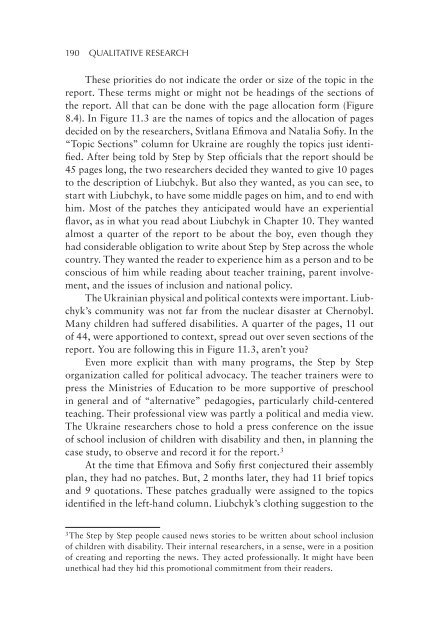How Things Work - Doha Academy of Tertiary Studies
How Things Work - Doha Academy of Tertiary Studies
How Things Work - Doha Academy of Tertiary Studies
Create successful ePaper yourself
Turn your PDF publications into a flip-book with our unique Google optimized e-Paper software.
190 QUaLItatIVe ReSeaRCH<br />
These priorities do not indicate the order or size <strong>of</strong> the topic in the<br />
report. These terms might or might not be headings <strong>of</strong> the sections <strong>of</strong><br />
the report. All that can be done with the page allocation form (Figure<br />
8.4). In Figure 11.3 are the names <strong>of</strong> topics and the allocation <strong>of</strong> pages<br />
decided on by the researchers, Svitlana Efimova and Natalia S<strong>of</strong>iy. In the<br />
“Topic Sections” column for Ukraine are roughly the topics just identified.<br />
After being told by Step by Step <strong>of</strong>ficials that the report should be<br />
45 pages long, the two researchers decided they wanted to give 10 pages<br />
to the description <strong>of</strong> Liubchyk. But also they wanted, as you can see, to<br />
start with Liubchyk, to have some middle pages on him, and to end with<br />
him. Most <strong>of</strong> the patches they anticipated would have an experiential<br />
flavor, as in what you read about Liubchyk in Chapter 10. They wanted<br />
almost a quarter <strong>of</strong> the report to be about the boy, even though they<br />
had considerable obligation to write about Step by Step across the whole<br />
country. They wanted the reader to experience him as a person and to be<br />
conscious <strong>of</strong> him while reading about teacher training, parent involvement,<br />
and the issues <strong>of</strong> inclusion and national policy.<br />
The Ukrainian physical and political contexts were important. Liubchyk’s<br />
community was not far from the nuclear disaster at Chernobyl.<br />
Many children had suffered disabilities. A quarter <strong>of</strong> the pages, 11 out<br />
<strong>of</strong> 44, were apportioned to context, spread out over seven sections <strong>of</strong> the<br />
report. You are following this in Figure 11.3, aren’t you?<br />
Even more explicit than with many programs, the Step by Step<br />
organization called for political advocacy. The teacher trainers were to<br />
press the Ministries <strong>of</strong> Education to be more supportive <strong>of</strong> preschool<br />
in general and <strong>of</strong> “alternative” pedagogies, particularly child- centered<br />
teaching. Their pr<strong>of</strong>essional view was partly a political and media view.<br />
The Ukraine researchers chose to hold a press conference on the issue<br />
<strong>of</strong> school inclusion <strong>of</strong> children with disability and then, in planning the<br />
case study, to observe and record it for the report. 3<br />
At the time that Efimova and S<strong>of</strong>iy first conjectured their assembly<br />
plan, they had no patches. But, 2 months later, they had 11 brief topics<br />
and 9 quotations. These patches gradually were assigned to the topics<br />
identified in the left-hand column. Liubchyk’s clothing suggestion to the<br />
3 The Step by Step people caused news stories to be written about school inclusion<br />
<strong>of</strong> children with disability. Their internal researchers, in a sense, were in a position<br />
<strong>of</strong> creating and reporting the news. They acted pr<strong>of</strong>essionally. It might have been<br />
unethical had they hid this promotional commitment from their readers.

















